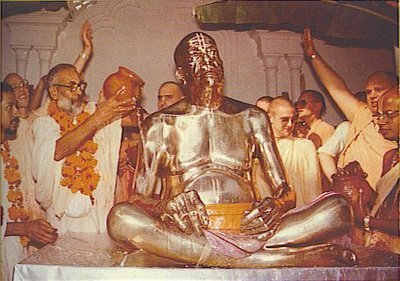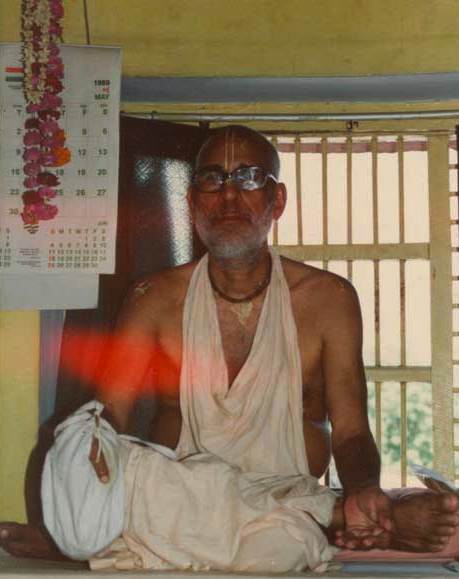Sri Srimad Bhaktivedanta Narayana Gosvami Maharaja
Four Discussions on Raga-Vartma-Candrika (Part 1)
Mathura, India: 1991
[In the early 1990s, Srila Narayana Gosvami Maharaja used to give darsanas for several members of the ISKCON GBC. During these few years, they requested him to discuss several Gaudiya Vaisnava literatures, such as Jaiva-dharma, Srimad-Bhagavatam Tenth Canto (Rasa-lila, Venu-gita, Brahmara-gita, and Gopi-gita) Harinama-cintamani, Vilapa-kusumanjali, and Raga-vartma-candrika.
In 1991, he led four discussions on Raga-vartma-candrika. Below is the first in that series, and we hope to send you the rest, one after another. As you may know, Srila Maharaja has requested that all his morning walks and darsanas be published, and he directed that these darsanas for the members of the ISKCON GBC be included:]
Sripad Tamal Krsna Gosvami: You said that today you would be speaking on Raga-vartma-candrika. You said you would be giving a synopsis; a summary.
Srila Narayana Gosvami Maharaja: Before beginning Raga-vartma-candrika, we first pray to our Gurudeva, Sri Srimad Bhakti Prajnana Kesava Gosvami Maharaja, and to Sri Srimad Bhaktivedanta Svami Maharaja, then to Srila Rupa Gosvami and Srila Raghunatha dasa Gosvami, and then to the author, Srila Visvanatha Cakravarti Thakura. We earnestly beg that their mercy comes to us, especially the mercy of Srila Visvanatha Cakravarti Thakura.
In this Raga Vartma Candrika, Srila Visvanatha Cakravarti Thakura tells us what he has realized about Sri Sri Radha-Krsna’s anuraga by the grace of Sri Caitanya Mahaprabhu and Srila Rupa Gosvami. Anuraga refers to that stage of prema which comes just before mahabhava. Within prema comes sneha, then mana, pranaya, raga, and then anuraga.*[See Endnote 1]
The author states, “I am writing something for those persons – those very lucky persons – who have greed for this raga*[See Endnote 2] but can find no path to enter for achieving it. This book serves as their guide, like a moonbeam (candrika), to shed light on the path (vartma) leading to the loving devotion of the residents of Goloka Vrndavana (raga). This path is very rare in the world.
During the Amavasya, dark-moon, night there is no moon; it is so very dark. There is a very narrow pathway, but it is not seen. If there would be a moon, that moon would give rays of light so that the path can be seen. This book is the candrika (moonbeam) which casts its light on raga and the path leading to raga. It is therefore called Raga-vartma-candrika.
We should know that this pathway is a very, very narrow one, meant only for a few, rare, highly-qualified persons; it is not for everyone. Srila Visvanatha Cakravarti Thakura advises that others not read this book.
However, there is no worldly qualification required to enter this path; the only qualification is lobha, or transcendental greed. It is stated in Bhagavad-gita, “Api cet sudaracaro bhajate mam ananya-bhak.” A man may be full of anarthas (undesirable habits and thoughts); but if he takes the association of a raganuga-bhakta and under his guidance reads the Tenth Canto of Srimad-Bhagavatam, he may become attracted and acquire a very deep greed to have the same transcendental mood as the Vrajavasis. He may be attracted to sakhya-rasa (friendship with Krsna), vatsalya-rasa (parental love for Him), or madhurya-rasa (a relationship with Him as a beloved). Simply by faithfully hearing Srimad-Bhagavatam’s descriptions of the moods of the gopis, or those of Krsna’s father and mother, or those of Krsna’s friends, one may begin to yearn to experience in his heart the same moods as theirs.
It may be noted, however, that Srila Visvanatha Cakravarti Thakura is not describing sakhya and vatsalya-bhava in Raga-vartma-candrika; he is presenting only gopi-bhava. In that regard, in order to attain that bhava, one will especially hear from a raganuga-bhakta the portions of the Tenth Canto discussing Krsna’s relationship with the gopis, namely Gopi-gita, Yugala-Gita, Bhramara-Gita, Pranaya-gita, and Venu-gita.
One who has samskaras (impressions in the heart) from having taken proper association in his previous births will be able to cultivate greed and achieve gopi-bhava by reading sastra; he will not have to rely on sastric logic to convince him. For such a person, this treatise will be the candrika for discovering the path of raganuga.
The author first explains that there are two kinds of sraddha (faith) – vaidhi and raganuga – which result in two kinds of bhakti – vaidhi-bhakti and raganuga-bhakti. Both types of sraddha are achieved through the association of qualified Vaisnavas. Where entrance in bhakti is impelled by fear, where it is induced by the injunctions of sastra that instruct everyone to perform bhakti to Krsna, otherwise they will go to hell – this is called vaidhi-bhakti.
In this way one may enter bhakti by fear; or, one may be impelled by the order of sastra which is based on yukti, reasoning. For example, sastra has ordered:
sa vai pumsam paro dharmo yato bhaktir adhoksaje
ahaituky apratihata yayatma suprasidati
["The highest pursuit for all humanity is suddha-bhakti – bhakti performed in order to please Krsna, the transcendent Lord Adhoksaja, by all one’s efforts of body, mind, and soul. Such uttama-bhakti is continuously performed without any personal desire (anyabhilasita-sunyam) and without any break. In this way one can fully satisfy the self (atma)." (Srimad-Bhagavatam, 1.2.6)]
By hearing such instructions, many people enter bhakti, and such bhakti is called vaidhi-bhakti.
Sripad Tamal Krsna Gosvami: This is vaidhi-bhakti.
Srila Narayana Gosvami Maharaja: And, that bhakti which is based only on genuine greed is called raganuga-bhakti. Such greed is generated by hearing the pastimes of Krsna and the gopis described in Srimad-Bhagavatam, by reading the books of the Gosvamis, and especially by being in the association of a raganuga-bhakta. Without the association of such raganuga-bhaktas, the pastimes of Krsna and the gopis will not be properly understood.
What is the nature of genuine greed? How can we know whether or not our greed is genuine?
When a sadhaka hears from raganuga-rasika Vaisnavas about the sweet pastimes of Krsna, especially His pastimes with the gopis, whether this be from Srimad-Bhagavatam, Krsna-Karnamrta, Ujjvala-Nilamani, Radha-Rasa-Sudha-Nidhi, or any other books, his citta-vrtti (heart) becomes very eager to aquire the moods of Krsna’s parikaras (associates). At that time he becomes absorbed in Sri Krsna’s rupa (form), guna (qualities), and lila (pastimes).
Sripad Tamal Krsna Gosvami: When the heart is filled with the qualities of Krsna, and the form of Krsna.
Srila Bhaktivedanta Narayana Gosvami Maharaja: Do you know the meaning of citta-vrtti?
Sripad Tamal Krsna Gosvami: Spiritual…inner… What’s the word? Inner…
Srila Bhaktivedanta Narayana Gosvami Maharaja: I want that word.
Sripad Tamal Krsna Gosvami: Consciousness? Inner consciousness?
Srimad Bhaktivedanta Narayana Gosvami Maharaja: Consciousness. In this connection citta-vrtti means ‘mind’ or ‘heart.’ When our citta-vrtti eagerly desires to be like those of Krsna`s eternal associates, in other words to have the moods of those eternal associates, that condition of the heart is its real or natural state, as opposed to the imposed worldly citta-vrtti.
At this time, the devotee is not interested in examining sastric orders. He will only want to achieve that mood which he sees in his asraya-gopi, the gopi for whose mood he has developed greed. This is genuine greed.
Do you understand? Can you say what is meaning of lobha, greed?
Sripad Tamal Krsna Gosvami: It is when a person hears the descriptions of Srimad-Bhagavatam about Radha and Krsna, and then thinks of the feelings the gopis have for Krsna.
Srila Bhaktivedanta Narayana Gosvami Maharaja: He wants to have…
Sripad Tamal Krsna Gosvami: He wants to have that same feeling that is within them, strongly; that is lobha.
Srila Bhaktivedanta Narayana Gosvami Maharaja: That is lobha, but you have left out one thing. Those with lobha are not regulated by sastric orders or bindings. Such orders are left untouched.
Sripad Tamal Krsna Gosvami: Rules and regulations are not there.
Srila Bhaktivedanta Narayana Gosvami Maharaja: The rules and regulations of sastra are not needed at all.
Sripad Tamal Krsna Gosvami: Otherwise it is vaidhi.
Srila Bhaktivedanta Narayana Gosvami Maharaja: For example, one may see some rasagullas or rabhries (Indian sweets) and, whether or not he has the money to pay for those sweets, he may at once develop greed for them. He will exclaim, “Very tasteful!” Similarly, in whatever stage a person may find himself, if he sincerely contemplates, “Oh! The mood of the gopis is very tasteful and very good. I have greed for that,” such greed has no bindings or consideration of sastric restrictions. If we judge that we are not qualified and we think that what we want is too high for us, this is a sign that we do not possess greed. Do you understand?
Sripad Tamal Krsna Gosvami: Please explain.
Srila Bhaktivedanta Narayana Gosvami Maharaja: If I desire a rasagulla but I think, “I have no money in my pocket to purchase it, so I cannot have it,” that means I have no real greed for it.
Sripad Tamal Krsna Gosvami: Greed goes beyond that.
Srila Bhaktivedanta Narayana Gosvami Maharaja: Somehow or other, by hook or by crook…
Sripad Tamal Krsna Gosvami: Beg, borrow, or steal.
Srila Bhaktivedanta Narayana Gosvami Maharaja: By stealing, or begging, or by any other means. Such a person does not think about his qualification or disqualification. He does not consider whether or not he is able to have this bhakti. He simply thinks, “I must have it!” This is real greed. Do you understand?
Sripad Tamal Krsna Gosvami: Heart’s desire.
Srila Bhaktivedanta Narayana Gosvami Maharaja: His desire must be overpowered by the form, qualities, and pastimes of Krsna. Then it will be called real greed.
A sadhaka may ponder, “I have heard from the rasika Vaisnavas how Lalita, Visakha, Citra, Rupa Manjari and other associates serve Krsna, and I want to serve like them.” Not judging whether he is qualified to achieve this samajati-bhava (the identical mood for which one aspires), if he does not wait for any logical argument to convince him, that it is called greed.
Sripad Tamal Krsna Gosvami: Argument means ‘reasoning.’
Srila Bhaktivedanta Narayana Gosvami Maharaja: It should come without relying on any reasoning. If reasoning is required, it is not greed.
The next consideration is this: When greed comes, how does one achieve his desired result? It comes by the association of raganuga-rasika Vaisnavas. In that association one reads Ujjvala-Nilamani, Bhakti-rasamrta-sindhu, especially Raga-vartma Candrika…
Sripad Madhava Maharaja: Vraja-riti Cintamani
Srila Bhaktivedanta Narayana Gosvami Maharaja: Vraja-riti Cintamani, Krsna-Karnamrta, Radha-Rasa-Sudhanidhi, Srila Jayadeva Gosvami’s Gita-govinda, and the books of Sri Kavi Karnapura and all our Gosvamis.
One will have to read all of these books and resolve: “How can I easily achieve that mood, somehow, by hook or by crook. What is the easiest method to get this?” This should be the question.
All of our acaryas, including Srila Visvanatha Cakravarti Thakura and Srila Bhaktivinoda Thakura, have recorded for us, in a practical way, how they themselves achieved it and how the sadhana-siddha-gopis achieved it. Their writings are authentic. One will search out their methods in sastra and follow the methods discussed therein, because without following sastra, without following the guidelines of Srila Rupa Gosvami, one will become sahajiya or atheist.
A person with greed will never judge his qualification; this is the main point. Rather, he will take assistance from these books. Srila Visvanatha Cakravarti Thakura is not personally present, but he is present through his books.
It is important to understand that this greed will not come by personal effort alone. It comes only by the grace of Krsna Himself and by the grace of a raganuga-bhakta. Without their mercy one cannot have it.
Bhakta-krpa, the mercy of Vaisnavas, is of two kinds: praktana (from previous lives), and adhunika (from this life). Praktana refers to mercy that comes from past births as well as the present birth. If a man has samskaras from his previous birth’s devotional activities and receives the mercy of a Vaisnava in this birth, he will very easily and quickly advance in bhakti. Perhaps he will not even have to again accept diksa, as in the case of some of our Gosvamis. Or, if he takes diksa, he will be seen to advance very rapidly.
Srila Haridasa Thakura, Sri Svarupa Damodara, and Sri Raya Ramananda did not reveal their guru-parampara; yet they received the association of Sri Caitanya Mahaprabhu and achieved their desired goal. This is an example of mercy due to purva-samskara, impressions accrued in previous births. [These transcendental personalities are eternal associates of Sri Caitanya Mahaprabhu, not conditioned souls, and therefore they do not depend upon past samskaras. Yet, when they appear in this world, they set an example for us by their behavior. -ed] Do you understand? I will question you.
Sripad Tamal Krsna Gosvami: All right.
Srila Bhaktivedanta Narayana Gosvami Maharaja: Do you know the meaning of samskara?
Sripad Tamal Krsna Gosvami: One has accrued some pious assets, purifications, and reformatory processes.
Srila Bhaktivedanta Narayana Gosvami Maharaja: I will be discussing the topic of samskaras, so try to understand the meaning.
If one has no previous births’ samskaras but has somehow obtained greed by the causeless mercy of a qualified guru or Vaisnava, this is called adhunika-krpa (krpa means ‘mercy’). Such a person receives diksa from a raganuga Vaisnava guru. Or, if he has received diksa before developing greed, then he accepts a raganuga Vaisnava as his siksa-guru. He may serve both his siksa- and diksa-gurus with equal devotion. Or, in some cases he may serve the siksa-guru more closely than his anusthana-diksa-guru (the guru who gives the initiation mantras according to pancaratrika-vidhi), as did Sri Syamananda Prabhu, Srila Raghunatha dasa Gosvami, and Srila Krsnadasa Kaviraja Gosvami. [Again, these transcendental personalities are not conditioned souls, but they give us many teachings by their own behavior. -ed]
Srila Raghunatha dasa Gosvami’s diksa-guru was Yadunandana Äcarya, and afterwards Sri Caitanya Mahaprabhu placed him in the hands of Sri Svarupa Damodara. Later, when Raghunatha dasa went to Vrndavana, he had the association of Srila Sanatana Gosvami and especially Srila Rupa Gosvami. Ultimately, Srila Raghunatha dasa Gosvami prayed to Srila Rupa Gosvami for all the activities of service described in his Vilapa Kusumanjali.
Krsnadasa Kaviraja Gosvami did not disclose the name of his diksa-guru; perhaps because he did not receive his devotional thoughts from him. Rather he acknowledged Rupa and Raghunatha, because he received all his moods from them. At the end of each chapter of his Sri Caitanya-caritamrta, he prayed:
sri-rupa-raghunatha-pade yara asa
caitanya-caritamrta kahe krsnadasa
["Praying at the lotus feet of Sri Rupa and Sri Raghunatha, always desiring their mercy, I, Krsnadasa, narrate Sri Caitanya-caritamrta, following in their footsteps."]
Why does Raghunatha dasa Gosvami pray to Rupa Gosvami? Svarupa Damodara is Lalita-devi, and is therefore more qualified than Rupa Gosvami, who is Rupa Manjari. Yet, Raghunatha dasa prays only to Rupa Gosvami. Why? It is because he does not want to be a nayika (beloved heroine) of Krsna like Lalita and Visakha.
Sripad Tamal Krsna Gosvami: He wants to be in manjari-bhava.
Srila Bhaktivedanta Narayana Gosvami Maharaja: Only manjari-bhava.
Sripad Madhava Maharaja: He wants to follow Rupa Manjari, because they are in the same category; the category of manjari.
Srila Bhaktivedanta Narayana Gosvami Maharaja: What is a manjari? We have heard about kamala-manjaris and mango-manjaris. Any creeper or good flower has manjaris. Although the manjari appears first and then the flower, the manjari is always located above the flower. When a bee comes to sit on the flower and drink its honey, the manjaris tremble, being overjoyed.
Similarly, the Krsna-bee comes to Srimati Radhika, She glances at Him, and They engage in loving pastimes (prema-vilas). Although the ‘bee’ does not sit on the manjari, the manjari trembles, feeling as if the bee is sitting on her. Whatever the ‘flower’ experiences in those pastimes manifests in the manjari, so there is no need for the bee to go to her. She automatically feels everything felt by the flower. If the bee kisses the flower, then, seeing this, the manjari feels that “the bee has kissed me.”
In fact, the manjari tastes something special, which even the flower does not taste, in the sense that the flower does not tremble as the manjari does. Similarly the maidservants of Srimati Radhika experience a pleasure in being Her maidservant, which She Herself dos not experience, and that pleasure is called bhava-ullasa rati.*[See Endnote 3]
Srila Raghunatha dasa Gosvami wanted to be a manjari, not a flower. In other words he did not want sakhi-bhava (the mood of Srimati Radhika’s friends like Lalita and Visakha, who have direct relationships with Sri Krsna). Do you understand? Herein lies the importance of the manjaris. In our sampradaya no one wants to be Sri Radha’s sakhi; they only want to be Her kinkari. Are you totally following my words? Do you know the meaning of the word kinkari?
Sripad Tamal Krsna Gosvami: Servant.
Sripad Madhava Maharaja: Maidservant
Srila Bhaktivedanta Narayana Gosvami Maharaja: There is no equivalent word in English for kinkari. It is such a beautiful Sanskrit word, which refers to something very soft, very fragrant, and so sweet.
We cannot learn these topics simply by reading books. No book will clarify the truths for you as we are discussing in this conversation. By discussing with me in this way, you can obtain more than what you can obtain by simply reading books.
Sripad Madhava Maharaja: These truths come only through realization.
Srila Bhaktivedanta Narayana Gosvami Maharaja: I do not say that I have any realization, but I have God’s mercy and Gurudeva’s mercy.
[*Endnote 1:
Sneha - tender affection
Maan - that stage of prema in which sneha reaches exultation, thus causing one to experience the sweetness of the beloved in ever new varieties (Ujjvala-nilamani 14.96), and when the nayika assumes an outward demeanor of pique which turns into transcendental anger and indignation arising out of jealous love.
Pranaya - that intensified stage of prema when maan assumes a feature of unrestrained intimacy known as visrambha, or confidence devoid of any restraint or formality. This confidence causes one to consider one's life, mind, intelligence, body, and possessions to be one in all respects with the life, mind, intelligence, and body of the beloved.
Raga - 1) an intensified stage of prema in which an unquenchable loving thirst (prema-mayi trsna) for the object of one's affection (Sri Krsna) gives rise to spontaneous and intense absorption in one's beloved, so much so that in the absence of the opportunity to please the beloved, one is on the verge of giving up his life; 2) when pranaya is experienced in the heart as immense pleasure. If by accepting some misery there is a chance to meet with Krsna, then that misery becomes a source of great happiness. And where happiness affords no opportunity to meet with Krsna, that happiness becomes the source of great distress.
Anuraga - an intensified stage of prema as defined in Ujjvala-nilamani (14.146): "Although one regularly meets with and is well-acquainted with the beloved, the ever-fresh sentiment of intense attachment causes the beloved to be newly experienced at every moment, as if one has never before had any experience of such a person."
Bhava - 1) loving emotions; a particular mood of love in which the devotee serves Krsna. 2) an intensified stage of prema which in Ujjvala-nilamani has been equated with maha-bhava, which occurs when anuraga attains a certain stage of exhilaration and relish. This can be experienced and relished only by anuraga itself and by no other bhava. When anuraga is adorned with the inflamed and exciting sattvika passions like molten gold and reaches its climax in Srimati Radhika, becoming identical with Her very temperament and dispositions, it is called bhava.
Mahabhava - the most mature stage of prema.
*Endnote 2: Here it is necessary to know the meanings of raga, raganuga and ragatmika. Regarding this subject, Srila Bhaktivinoda Thakura says that the excessive attachment for many forms of sense enjoyment, which the materialist feels through natural contact with the sense objects, is called raga. Just as the eyes become agitated on seeing something beautiful, in the same way all the senses are always eager to taste pleasure, and thus the heart develops attachment (raga) for the sense objects. When Krsna is the exclusive object of this raga, it is called raga-bhakti. Srila Rupa Gosvami has defined this raga as iste svarasiki raga paramavistata (BRS 1.2.272). “The strong, natural and complete absorption in the cherished object of one’s devotion arising from an unquenchable love filled thirst is called raga.” When one is engrossed in krsna-bhakti at this level, it is called ragatmika-bhakti. This bhakti is especially found in the Vrajavasis, the eternal residents of Vraja. And, that bhakti which follows the moods of the ragatmikas is called raganuga. In other words, when, by the mercy of Sri Krsna and His devotees, one cultivates bhakti impelled by the greed to obtain the same mood as Krsna’s beloved associates, it is called raganuga-bhakti. (Raga-vartma-candrika, verse 2, purport by Srila Narayana Gosvami Maharaja)
*Endnote 3: bhava-ullasa-rati – Generally, devotees of the same mood and who are enriched with similar desires naturally share suhrd-bhava, intimate friendship, with each other. That is why the love and affection that Lalita and the other sakhis have for Srimati Radhika is called suhrd-rati. When their suhrd-rati is the same as or slightly less than their Krsna-rati (affection towards Sri Krsna), this is called sancari-bhava (a temporary emotion that is compared to the waves that swell and then return to the ocean of their permanent emotion of the mood of Krsna's beloveds). In other words, this suhrd-rati becomes like the waves in the ocean of their prominent affection for Krsna; it is a sancari-bhava.
 Srila Maharaja leading the ISKCON GBC and other devotees in performing Srila Prabhupada's divine samadhi festival after he gave Srila Prabhupada samadhiIn the case of the manjari-sakhis, their suhrd-rati (for Sri Radha and everything connected with Her), which abundantly exceeds their krsna-rati and which constantly increases by the moment due to their full absorption in it, is called bhava-ullasa-rati. This is a special feature of madhura-rasa. Of the five types of sakhis, only the nitya-sakhis and prana-sakhis, who are known as manjaris, have this bhava-ullasa-rati as their permanent emotions (sthayi-rati). It is no longer just a sancari-bhava. These manjaris nurture an abundance of sneha, tender affection, for Radhaji.
Srila Maharaja leading the ISKCON GBC and other devotees in performing Srila Prabhupada's divine samadhi festival after he gave Srila Prabhupada samadhiIn the case of the manjari-sakhis, their suhrd-rati (for Sri Radha and everything connected with Her), which abundantly exceeds their krsna-rati and which constantly increases by the moment due to their full absorption in it, is called bhava-ullasa-rati. This is a special feature of madhura-rasa. Of the five types of sakhis, only the nitya-sakhis and prana-sakhis, who are known as manjaris, have this bhava-ullasa-rati as their permanent emotions (sthayi-rati). It is no longer just a sancari-bhava. These manjaris nurture an abundance of sneha, tender affection, for Radhaji.
It is seen that creepers are always endeavoring to embrace trees, but the leaves, flowers and buds (manjaris) of the creepers do not even slightly try to embrace the trees directly. When a creeper embraces a tree, the joy of those flowers, leaves, and manjaris automatically increases. In Sri Vrndavana Srimati Radhika stands supreme among all gopis. She is famous as the kalpa-lata (the creeper that fulfills every desire) of love for Sri Krsna. Some of Her sakhis have the nature of leaves, some are like flowers, and some like manjaris. That is why they are always eager for Srimati Radhika to meet with Krsna, and are carried away by the bliss of Their union. (Srila Narayana Gosvami Maharaja's commentary on Venu-gita, verse 7)]









